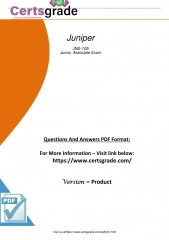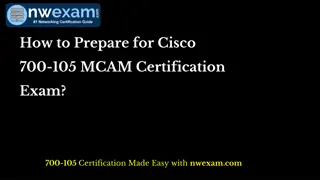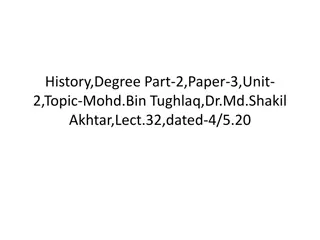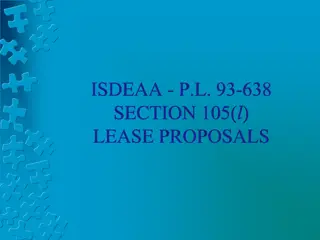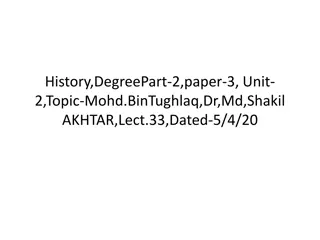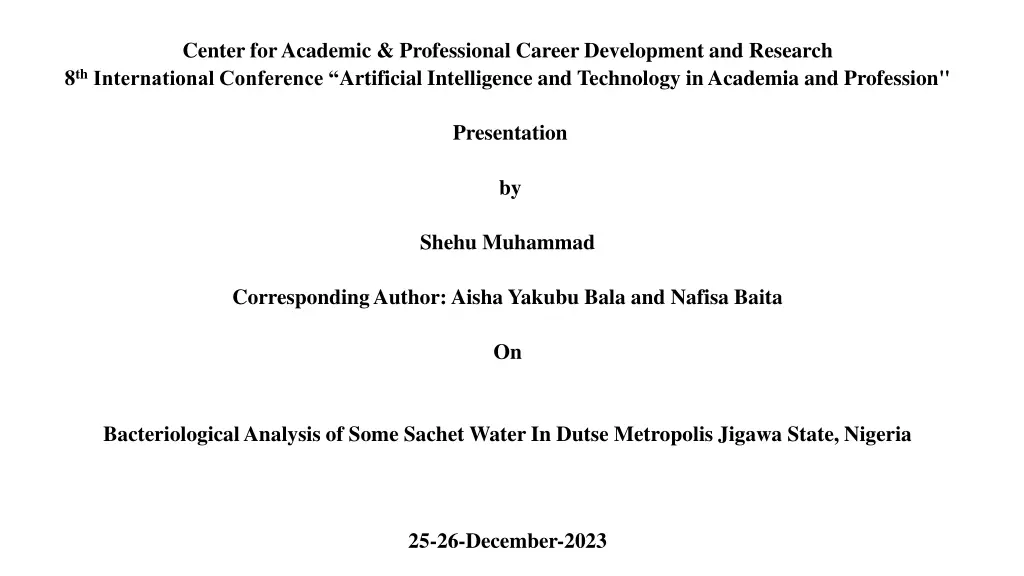
Bacteriological Analysis of Sachet Water in Dutse Metropolis
Explore the bacteriological analysis of sachet water in Dutse Metropolis, Jigawa State, Nigeria, highlighting the potential health risks associated with microbial contamination. Learn about the importance of water quality assessment and the impact on public health. Join the discussion on the safety of drinking water and the need for rigorous testing procedures to ensure consumer well-being.
Download Presentation

Please find below an Image/Link to download the presentation.
The content on the website is provided AS IS for your information and personal use only. It may not be sold, licensed, or shared on other websites without obtaining consent from the author. If you encounter any issues during the download, it is possible that the publisher has removed the file from their server.
You are allowed to download the files provided on this website for personal or commercial use, subject to the condition that they are used lawfully. All files are the property of their respective owners.
The content on the website is provided AS IS for your information and personal use only. It may not be sold, licensed, or shared on other websites without obtaining consent from the author.
E N D
Presentation Transcript
Center for Academic & Professional Career Development and Research 8thInternational Conference Artificial Intelligence and Technology in Academia and Profession" Presentation by Shehu Muhammad Corresponding Author: Aisha Yakubu Bala and Nafisa Baita On Bacteriological Analysis of Some Sachet Water In Dutse Metropolis Jigawa State, Nigeria 25-26-December-2023
Introduction Water is a substance composed of chemical elements two molecules of hydrogen and one molecule of oxygen. It exist in 3 states solid, liquid and gas. It can contain unwanted chemicals from natural source or agricultural activities pathogenic microorganisms and undesirable organoleptic properties like odour, color and taste Codex (2001). The greatest risk to human health is from faecal contamination of water (it may be contaminated with faecal material of human or animals) (Codex, 2001). 2
Introduction cont., Bacteriological quality assessment is of principle concern because of the acute risk to health posed by viruses, bacteria and helminths in drinking water. It has been estimated that the mortality of water associated disease exceed 5 million people per year around the world (Gleick, 2002).Of these, there are reports that more than 50% of these deaths are associated with microbial intestinal infections, particularly with cholera and typhoid. The World Health Organization (WHO) estimated that 1.1 billion of the world s population does not have access to safe water. In addition, 80% of disease and one-third of deaths in developing countries are due to consumption of contaminated water (WHO, 2011). 3
Statement of research problem The sale and consumption of sachets water continues to grow rapidly in Dutse and other places within the state and the country. Drinking water regardless of it source, is usually subjected to one or more of a variety of treatment processes intended to improve its safety and aesthetic quality. The study will determine the safety of some sachets water because there is possibility of fecal contamination in the sachet water which may lead to health risk among the population who consume the water(Kott etal., 1974). 4
Justification of the study There has been countless number of disease outbreak and poisoning around the world resulting from consumption of untreated or poorly treated drinking water (Fong et al., 2007).As the results of these there Is need to analyse the water sample to estimate the numbers of bacteria present in the water sample. 5
The specific aim and objectives of the study Aim of the study The aim of this study is to determine bacteria that are associated with some sachet water commonly sold in Dutse metropolis. Objectives of the study are to; i. To isolate and identify bacteria associated with sachet water sold within Dutse of Jigawa statedetermine the antibiotic sensitivity pattern of K. pneumoniae isolated from Sputum, Blood and Urine sample. ii. To determine the coliform counts (Most Probable Number) of the water samples and compare the result with some national and international standard.determine the present of ESBLs isolates using molecular methods. 6
Materials and methods Study area This study was carried out in Dutse of Jigawa State, Nigeria. It has latitude of 11o42 8.46 N and a longtitude of 9o20 2.46 N with an estimated population of 431,800 (NPC, 2022). They major ethnic group are Hausa Fulani With availability of agrarian land,. The inhabitants of Dutse are predominantly farmers; other occupations typical to rural area are also available among the populace. 7
Materials and Methods cont., Three(3) different brand of sachet water sample was collect Using Random Sampling directly from vendors in Dutse of Jigawa State for two days to correct for bias in sampling .each day the sample were brought to the lab for analysis within 2 hours of purchase. 8
Materials and Methods cont., STANDARD PLATE COUNT/TOTAL BACTERIAL COUNT Serial dilution of each sample was prepared using distilled water and 10 dilution was used. 0.1ml of 10 was aseptically poured onto the center of a sterile petri dishes containing 20ml of nutrient agar that are labeled with appropriate name of the water sample (sample A & sample B).the inoculated water sample was spread gently on the surface of the agar using a sterile glass rod, all the plate were incubated at 37oC for 24hrs.the same procedure was aseptically repeated on the next day to obtained an accurate result MATERIALS Water sample(2 Brands) Nutrient agar, Macconkey broth, Eusine Methylene Blue agar, Lactose broth, Distilled water, Saffranin, Crystal violet, Iodine,Peptone water, Ethanol, Kovac s reagent, MR-VP broth, Methyl red solution, 40% KOH solution, Simmon citrate agar, Alpha-Naphtol. MEDIA PREPARATION -2.8g of nutrient agar was dissolved in 100ml of distilled water . 1% peptone water was dissolve in 99ml of distilled water -8g of macconkey broth(double strength) was dissolved in 100ml of distilled water 9
Materials and Methods cont., TOTAL COLIFORM COUNT The method adopted here is known as presumptive test For each sample (A & B) 24g of MacConkey broth was dissolve in 300ml of distilled water and was distributed into a 3 bottles of 50ml amount and15 bottles of 10ml amount each containing an inverted Durham tubes. The bottles with the media were covered with cotton wool and sterilize in an autoclave at 121oC for 15minutes.the media was allowed to cool down for some minutes.each one 50ml bottle and five 10ml were labeled with the name of the water sample to differentiate it.therefore,each 5 bottles containing 10ml was inoculated with 10ml of the appropriate water sample(A&B) and also 50ml of water sample was inoculated to a 50ml macconkey broth and were incubated for 24hrs at 41-43oC after been loosely capped.the result was observed and this method was repeated on the next day for the second sample. Confirmatory test This was done by transferring 2 loopful of culture from positive tubes of presumptive test (tubes of macconkey broth that change color from reddish purple to yellow and there is gas production in an inverted durham tubes) to a tube of brilliant green lactose bile broth (oxoid) with an inverted durham tubes.the tubes were incubated at 44-45oC for 24-48hrs for fecal coliform & gas production. 10
Materials and Methods cont., Completed test This step was done by streaking a loopful of broth in Eosine methylene blue agar from positive tubes of pure colonies .the plates were incubated at 37oC for 24-48hrs.growth of colonies on E.M.B was observed using culture characteristics,morphology and biochemical test. 11
Results Table 1. Physical Examination of Sachet Water Sample Product Name Manufact urer Add Manufact uring Date - Expiring Date NAFDAC No. Batch No. A + + - + - B + + - - + - Keys: + indicate present and indicate absent 12
Results Cont., Table 2. Total Bacterial Count Of Sample A Obtained For 2 Days S/N Sample CFU/ml 1 Day 1 4.8 x 10 2 Day 2 5.6 x 10 13
Results Cont., Table 3. Total Bacterial Count Of Sample B Obtained For 2 Days S/N Sample CFU/ml 1 Day 1 3.6 X 10 2 Day 2 5.6 x 10 14
Results Cont., Table 4. Presumptive test of two days obtained from brand A using MPN techniques. S/N 1(50ml) 5(10ml) MPN/100ml 1 0 5 7 2 1 5 18+ 15
Results Cont., Table 5. Presumptive test of two days obtained from brand B using MPN techniques. S/N 1(50/50ml) 5(10/10ml) MPN/100ml 1 1 4 16 2 1 5 18+ 16
Discussion Bacteriological analysis of some sachet water sample sold within dutse metropolis shows that coliform bacteria including E.coli were detected in some samples indicating recent human or animal fecal contamination of the sachet water sampled and analyzed.This is attributed to either fecal contamination or poor sanitation during purification ,sealing ,transportation, selling or consumpsion. This research shows that the sachet water sample collected from 2 different brand contain high level of total bacteria counts. Both sample A &B of day 2 were found to have highest total bacteria counts as shown in table 4.2 and table 4.3 above. The total bacterial count of water sample A&B were generally high exceeding the limit recommended by WHO (1.0X 102) which is the standard limit of bacteria count of drinking water. These may therefore, be used in assessing the cleaniness of different brand of sachet drinking waters sold within area of study. The most probable number for presumptive total coliform count of the water samples ranged from 0- 2/100ml according toWHO standard for drinking water 17
Discussion cont., The isolated bacteria include:Escherichia coli, Pseudomonas, Proteus vulgaris ,Salmonella, Enterobacter aerogenes, Citrobacter and Klebsiella spp.presence of this organisms in water could cause the incidence of diarrhea, food poisoning and gastroenteritis among the society. According to World Health Organization (2002) report, a bacteria count concentration does not itself present a risk to human health. Nevertheless, bacteria counts are used as good indicators of the overall quality of production (Obiri et.al.,2003). The most probable number for presumptive total coliform count of the water samples ranged from 0-2/100ml according toWHO standard for drinking water.Water sample A &B had the highest coliform count of about 18MPN/100m as shown in table 4.4 and table 4.5, Bacteriological analysis of sachet water commonly sold in Dutse metropolis indicates the most of the sachet water did not meet the requirement of WHO standard for portable water which could be attributed to the bacterial contaminants that could have been introduced during the processing, packaging and distribution stages. 18
Conclusion The result of this research shows the Microbiological or bacteriological analysis of 2 different brand of sachet water sample sold within Dutse metropolis of Jigawa State, Nigeria using the most probable number of coliform( MPN) for enumeration of total coliform count and standard plate count for enumeration of Total bacterial count.the count were generally high exceeding the limit recommended by both Environmental Protection Agency (EPA) and World Health Organization (WHO) of 1.0 X 102cfu/ml.The exceeding of this limit raise public health concern that need to be addressed and need for microbial assessment of water for production of drinks should also be emphasized to reduce possible contamination. The presence of total coliforms and E.coli in concentration that make the products unfit for human consumption according to WHO and NAFDAC recommendation and guidelines. 19
Recommendation Assessment of water quality at some important stages of pre-production, production and post production stages at the factories is suggested in order to ensure quality and safety. Standard organization of Nigeria (SON) should be actively involved in the inspection and regulation of the quality of packages used in packaging water. NAFDAC and Ministry of Health need to get the producers of packaged water to comply with the National drinking water guidelines. All water that fails NAFDAC & WHO regulations should be withdrawn from the market 20
References Awoyemi A.O, Aderibigbe S.A, and Osagbemi G.K (2008). Availability, Adequacy and Quality of Water Suppy in Illorin Metropolis,Nigeria,European Journal of Scientific Research, 23:528-536 Chessbrough, M(2000). District laboratory practice in tropical countries , 2nd Ed.,Cambridge University Press, New York:143-155 Codex (2001). Recommendation International Code of Practice,Code of Hygienic Practice for Bottled/Packaged Drinking Waters, 48, Rome:Codex Alimentarius Commission. Codex (2009).Hazard Analysis and Critical Control Point(HACCP), System and Guidelines for its Application,4th E Clinical and Laboratory Standards Institute CLSI. Hogg S.(2005). Essential Microbiology, John Wiley and Sons Ltd., England:pp 24 Hunter P.R (1997). Waterborne Diseases: Epidemiology and Ecology, John Wiley and Sons,ChichesteR,United Kingdom:27- 30 Ibemesim, A.O. (1998). Physiochemical and Microbiology Qualities of Harvested Water, AB Tech Citation in FUTO:2-16 Ibemesim, A.O. (2014). Comparative Study of Sachet and Bottle Water Sold on the Street of Abuja, Nigeria South America Journal of Public Health, 2(3): 311 Jay, M.J.,Loessner, J.M. and A.D (2005). Modern Food Microbiology, 7th Ed., Springer Science/ Business Media Inc., New York: 21


